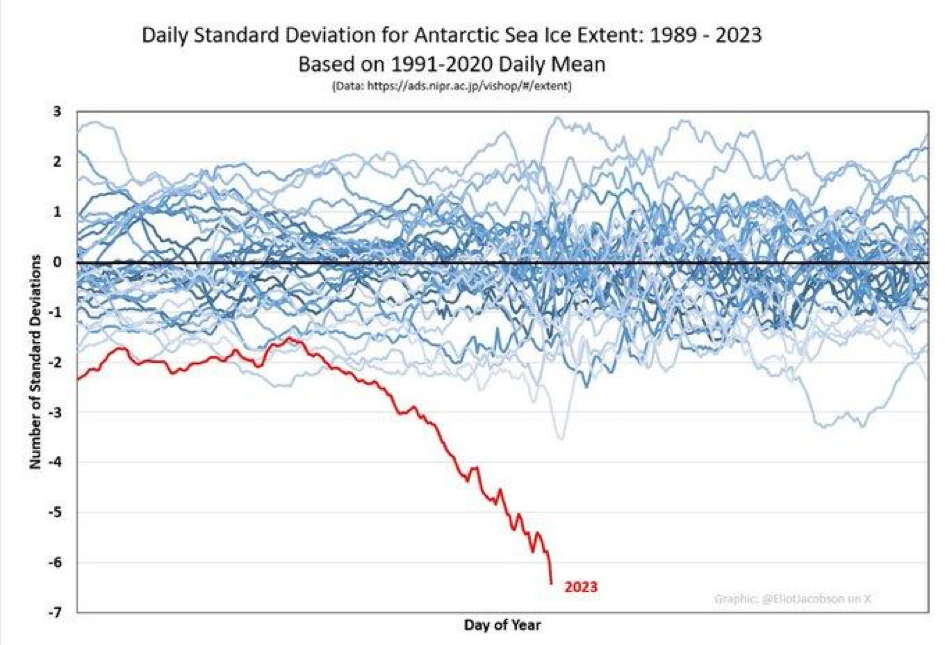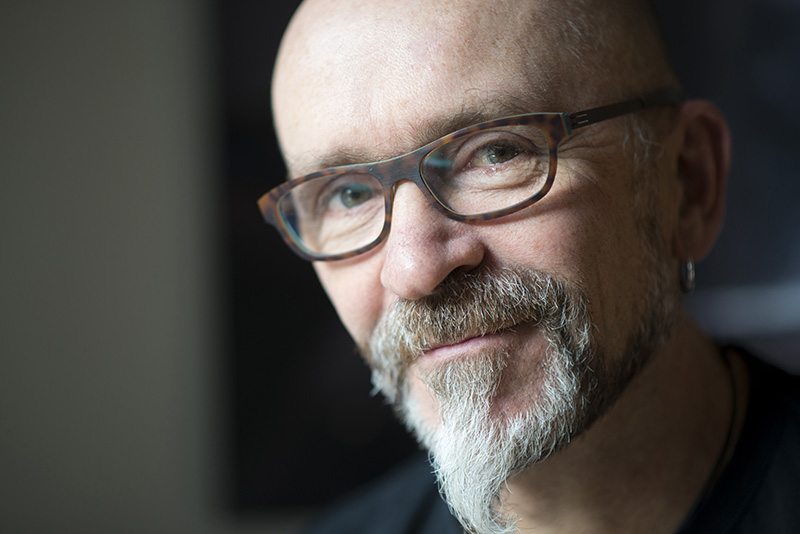SOAPBOX
★ ★ ★ ★
WORLD ON FIRE

By Mike Hembury
“The era of global boiling has arrived” – UN General Secretary Antonio Guterres
Summer’s here. At least, up here in the Northern Hemisphere, summer has been and almost gone, easing its way into autumn as the nights get a little longer, the kids get ready for a new school year, the neighbours get back from their summer holidays. It’s a time for slowing down, right? For taking stock and chilling out, for enjoying the good things in life.
Sure, it’s all of that. Except that this year, it’s also a time of speeding up, of global excesses, of portents and terrible warnings.
July 2023 will probably go down in history as the month the climate crisis really began to bite, the month that saw heat records tumble and numerous critical indicators of planetary tipping points literally go off the charts.
In fact, so numerous were the alarm signals that it’s difficult to know where to start, but here goes.
As a result of four simultaneous giant heat domes spanning the world, July saw not only the record for global temperature being smashed, but 24 days in a row of record global temperatures, making it in all probability the hottest 24-day period in the last 100,000 years. Countless locations around the world have seen their all-time temperature records smashed by as much as 2°C. On July 17, the temperature at Persian Gulf International Airport in Tehran was recorded at 66.7 °Celsius or 152° Fahrenheit, a temperature generally considered to be inimical to human and most animal life. At the same time, the concomitant intense heatwaves have caused dramatic wildfires to break out in the dried-out countries around the Mediterranean, including Greece, Algeria, Tunisia, Morocco, Italy, Croatia and Syria.
Renowned climate expert James Hansen, who famously first warned the US Congress about global warming back in 1988, said that the world is heading for a superheated climate and that we are “damned fools” for letting it happen. And as the frequency and intensity of wildfires increase, so to do the associated carbon emissions, with Canada’s 2023 wildfire season alone emitting an estimated one and a half billion tons of carbon so far, triple the country’s normal annual emissions from fossil fuels, and more than the combined emissions from a hundred nations.
In addition to searing and soaring land temperatures, sea temperatures have also been going off the charts. In late June, temperatures in the North Atlantic off the coast of Ireland were 5° C higher than normal, a Category 5 (“Beyond Extreme”) heatwave according to the US National Environmental Satellite, Data and Information Service. The UK’s New Scientist magazine wrote that “For more than three months, sea surface temperatures in the North Atlantic have been higher than any on record during this time of the year”. On July 24th, the average sea surface temperature for the Mediterranean Sea reached 28.4°C, the highest in recorded history, whilst on the same day, sea temperatures of over 38° C / 101 ° F – higher than human body temperature – were recorded at Manatee Bay, Florida. And whilst the link between high seawater temperatures and mass fatalities of marine life has been clearly established, an even greater threat seems to be unfolding in the Antarctic, where increased sea temperatures mean that sea ice is failing to form in winter. The likelihood of this happening under normal conditions is so low that it has been referred to as a “Six-sigma event … otherwise known as a once-in-7.5-million-year event“. (Six sigma means that it is six standard deviations from the norm). At the time of writing, temperatures in the Antarctic are 38.5°C above the norm, and ice losses currently correspond to the IPCC “worst case” climate scenario.
The failure in Antarctic ice formation also spells likely extinction for iconic species such as the emperor penguin, with fresh data showing that no chicks survived in 4 out of 5 breeding colonies in the spring of 2022.

Whilst the ice in the Southern Ocean is clearly in peril, the prospects for the sea ice in the Arctic are equally dire, with researchers reporting that it is already “too late” to save sea ice in the Arctic summer. Taken together (along with the risk to ice in Greenland and the glacier ice of mountain regions) this means a threat of massively increased sea levels, perilous consequences for the currents that power ocean circulation, and the potentially catastrophic collapse of entire marine food chains, starting with the tiny krill and plankton of the southern and northern oceans, right up to the fish, whales and other mammals (including ourselves) that depend on them.
If this account sounds a little frenetic, it’s basically because records are tumbling so fast that it’s becoming difficult to keep up. And while scientists around the world continue to sound the alarm in whatever way they can, the UN General Secretary Antonio Guterres summed it up in typically succinct manner:
“All this is entirely consistent with predictions and repeated warnings. The only surprise is the speed of the change. Climate change is here, it is terrifying, and it is just the beginning. The era of global warming has ended; the era of global boiling has arrived.”
And although it was the temperature anomalies that grabbed the headlines, the summer of 2023 has also seen the emergence of another spectre closely related to climate breakdown – the prospect of extensive crop failures, shortages of basic foodstuffs, and famine on a previously unthinkable scale. Even without the Russian blockade of Ukrainian wheat exports, European grain production is expected to take a serious hit. Cereal production in southern Europe is expected to fall by up to 60% on last year, rice production is well down in China and Pakistan due to extensive flooding, and India has banned wheat exports after a catastrophic harvest in 2022.
Taken as a whole, the extreme seriousness of the situation is obvious. The window of opportunity for sticking to the target of 1.5° C of warming, as set out in the Paris Agreement, is closing rapidly. Professor Sir Bob Watson, former head of the UN climate body, told the BBC’s Today programme he was “pessimistic” about sticking to 2° of warming. “The big issue is we need to reduce greenhouse gases now to even be on the pathway to be close to 1.5C or 2C. We need to reduce current emissions by at least 50% by 2030. The trouble is the emissions are still going up, they are not going down”.
How then, did we get into this mess, and how do we get out of it?
The answer to the first question is relatively easy. We’re here because world elites – our governments, fossil fuel, automobile and airline companies, neo-liberal capitalist politicians and the lobbies that support them – want us to be here. They have refused to act. They have lied, cheated, covered up, delayed and countenanced death and destruction on a phenomenal and growing scale, all to preserve the status quo, their earnings and their profit model. They would literally rather see the death of the planet than the end of capitalism.
If we had started to take serious action back in 1988, we could have gradually phased out fossil fuels and avoided the worst effects of the crisis, which, it has to be said – are still to come. Now, only a radical reduction in fossil fuel emissions can give us any chance of earth staying within the safe operating zone for human and animal life.
If we take the UK’s catastrophic Brexit process as an analogy, then our elites have been pushing for a “hard” climate breakdown, rather than the soft landing that was still on the cards even a decade or two ago.
The question of responsibility, of culpability, with regard to this situation is difficult to put into words. Extinction Rebellion’s founder, Roger Hallam, put it like this:
“The point is not that what is happening is murder for the sake of murder. The present day elites do not want people to die just because of who they are – they are not Nazis. Nor is the point that this is indeed murder, in the sense that our elites are happy to have people die as a necessary means for them to maintain their power. No. The point is this – it is the scale and duration of the killing which is necessary for the elites to maintain their power. They are not Nazis, and at the same time they are worse than Nazis“.
Whether or not we agree with his comparison, Hallam’s basic point here is irrefutable: By their actions, present global elites are fundamentally changing the planet in a way which will lock in unimaginable death and suffering for all of humanity for the foreseeable and unforeseeable future.
Which leads us to the second question, i.e. what can we do to save the world?
In policy terms the answers are relatively easy to sum up: Stop burning fossil fuels, transition to renewable energy, stop methane emissions, stop and reverse deforestation, change what we eat.
Taken together, that’s a package of measures that could help stop global warming. It won’t be easy, but it’s the path we have to go if we want to save human civilisation. Although it has to be said that warming will continue until we reach net zero, and the climate consequences will continue to get worse until that happens.
Even if we manage to get the climate to stabilize at a new level, it’s going to be immeasurably worse for human and animal life than before the pre-industrial baseline. Reversing that will be a task not only for us, but for all human generations to come.
Of course, if it were just a question of simply implementing rational policy decisions, we wouldn’t be in this mess. Instead it’s more a matter of forcing governments to act as a matter of urgency, or, better still, getting rid of the whole corrupt network of pro-fossil-fuel ecocidal procrastinators who have pushed the world to the brink of destruction.
But it’s the end of summer.
It’s a good time to take stock.
It’s a good time to let the message sink in that after thirty years of global inaction, our planet, and our so-called civilisation, is solidly on track for catastrophe.
That’s tough data to digest. All the more so if you have children, grandchildren or care in any way about what we’re bequeathing to future generations.
We know something bad is coming. And that in many ways it is already arriving. We just don’t know how bad it’s going to get.
And although it’s too late to “avoid” climate change, it’s never too late to stop making it worse. But the longer we wait, the more difficult it gets.
All we can do now is get organized, get angry, get out on the streets.
As long as fossil fuels are being subsidized to the tune of $13 million per minute, we know that the bastards who rule us are not doing enough.
The next Global Climate Strike is scheduled for 15th September 2023. Make sure you – and everyone you know – are there!

Mike Hembury is an Anglo-Berliner originally from Portland, England. He’s a writer, translator, musician, coder, sailor, environmentalist and guitar nerd in no particular order. He is the author of New Clone City, nominated as a “Hot Berlin Read” by Exberliner magazine. You can follow Mike on Twitter here: twitter.com/schnappz
























0 Comments
Trackbacks/Pingbacks